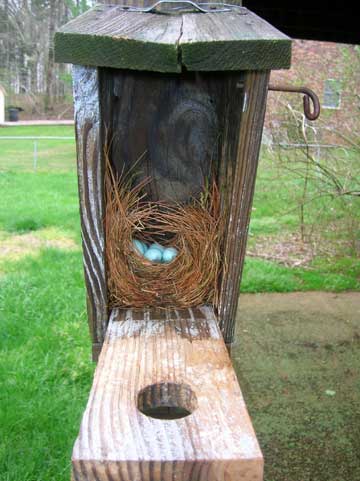 by Preston MacDougall April 17, 2006
It is truly surprising how frequently this bit of mysterious advice actually works. It worked for Ray Kinsella in the movie "Field of Dreams", where, planted with his dreams, a cornfield sprouted fulfillment of one man's passion for baseball. It worked for me too, only in my case it was "buy it and they will come". And "they" weren't the Chicago Black Sox, or the White Sox - they were much too big, especially the big hurt, Frank Thomas. When I lived in Toronto, I saw that the Blue Jays are smaller than they appear on TV, but even they were much too big.
Amazingly, only Eastern Bluebirds build nests in the wooden box that my family bought several years ago. They do it every year, starting when spring is in the air. Usually I notice that the process has begun again when the iridescent blue wings of the male beat a flight path to its wooden door. It is fascinating to watch the male and female take turns flying in pine straw, grass hay, or other materials held in their beaks. I don't know if they have a dream, or if it's just instinct, but from the quick in-and-out flight activity it is clear that they mean business. They enter the box through the oval hole that measures 4.7 centimeters in height and 3.8 centimeters in width. Online, you can obtain instructions for building your own Bluebird box, and measurements are usually given in inches - one and a half inches is just right for the width. Any bigger and Starlings may nest in the box, any smaller and some little Chickadees may call it home. While we humans can get quite excited over whether the hole should be measured in inches or centimeters, to an Eastern Bluebird the size is simply one "me". When the nest is a couple inches deep, the female will spend long periods in the box. When she leaves, she doesn't seem to mind if I open the door and examine the nest and beautiful blue eggs, each about 2 cm in length. She usually lays one egg each day. Currently, we have a clutch of 5 eggs just in time for an Easter surprise. Or is it a miracle? I know one thing; it isn't a dream. We have had at least one clutch of eggs hatch, chirp for food, grow up, and fly away, every year. (Except for the year that an opossum had a midnight snack, which was quite a nightmare since my wife and I heard the whole thing. Whether you build or buy, I suggest that you reinforce your box somehow - small nails will not deter a hungry nocturnal carnivore.) Just as surprising to me is the story of the discovery of crown ethers at the DuPont Company. Charles Pedersen, an organic chemist at DuPont, shared the 1987 Nobel Prize in Chemistry with academicians Donald Cram and Jean-Marie Lehn. The three were recognized for their independent roles in the "development and use of molecules with structure-specific interactions of high selectivity". Pedersen's account of the dawn, in 1967, of what Jean-Marie Lehn calls "supramolecular chemistry" - or the chemistry of molecules that self-assemble and do things that they were designed to do - is fittingly jubilant. His Nobel speech, which is available online at nobelprize.org, contains the following passage: "Another aspect of this discovery filled me with wonder. In ordinary organic reactions only rings of 5, 6, or 7 members form easily. Here a ring of 18 atoms had been formed in a single operation". The key to this chemistry was that alkali metal ions assisted in the process, essentially wrapping themselves with organic molecules (specifically aromatic alcohols and chlorinated ethers) that reacted with each other to form a snug "crown ether" that could then be separated from the metal ion. The identity of the ion determines the size of the ring that is formed, and the size of the ring determines which ion will later be "selected" by the ring to form a complex. For instance, 15-crown-5 molecules, with holes that measure about 0.2 nanometers, will bind sodium. But 18-crown-6 molecules, with holes about 0.3 nanometers wide, will bind potassium. Pedersen's crown ethers spawned a growing family of molecules that form incredibly specific host-guest interactions. New generations of chemists are learning how to engineer more and more complexity into these reliable and reproducible acts of recognition. The hope is that this "nanotechnology" will contribute more and more to the fulfillment of society's dreams.
Publish A Letter on SitNews Read Letters/Opinions Submit A Letter to the Editor
|
||
